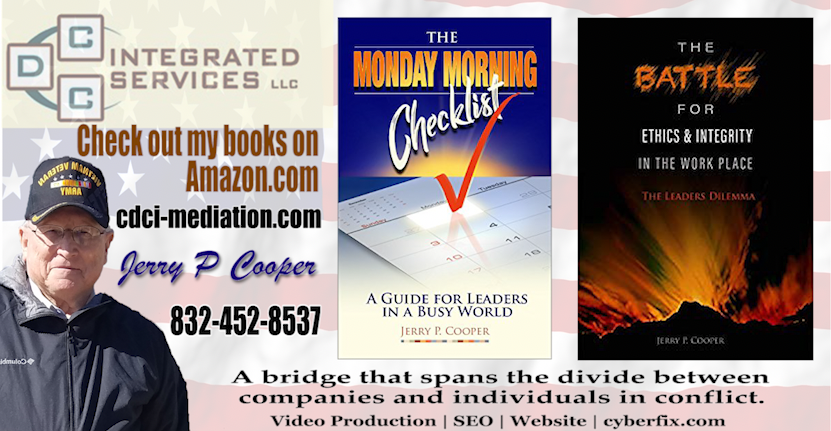Volume 5 | Issue 8
Putting it in contextA message from CDC Integrated Services, LLC
359 Billion And You Are Responsible
359 Billion And You Are Responsible
Employees at all levels in a company find ways around conflicts in the workplace. Just about everyone finds creative ways of coping with conflict in the office and working around the individuals and issues at the core of the conflict. In today’s environment uncertainty over how to address such conflicts is increasing instead of decreasing, and it frustrates many company leaders that it does not become easier. Many of them don’t know or accept they remain part of the problem.
About four years ago Dr. Dan Dana of the Mediation Training Institute International stated, in part …“un-managed conflict is the largest reducible cost in organizations today, and the least recognized”. I find it interesting that most company leaders can reduce to dollars and cents the impact of unresolved disputes between their company and a client or contractor, yet most employees don’t know this information.
Reasons may exist for not sharing that type of data with employees, but, with very few exceptions, employees at all levels in any given company do not know the cost of disagreements and disputes in the workplace, and this needs to change. The cost of conflict needs to be part of the conversation between and among employees at all levels, and the leadership must be front and center making it clear it sees these conversations as necessary and important.
How much are we talking about? A study produced for the Myers-Briggs organization a few years ago estimated that 385 million workdays were spent trying to address, work through, workaround, or otherwise mitigate the adverse effects of conflict. The authors of the study further estimated those lost workdays equated to $359 billion in salaries and wages spent on conflict avoidance that should have been spent on products, services, and all the other things that add value to a company’s brand.
Every leader worries about the very real probability that one careless word, like a catalyst, can trigger a dispute or a series of disputes that expand rapidly out of control and cause damage far out of proportion to the initial event. In this environment where workers have different cultural backgrounds, differing skills with language, and different approaches to problem solving, it becomes imperative that managers and employees understand these consequences and the financial impact that results from avoidance.
A company’s leadership must master certain skills before creating the expectation among the rank and file that conflict resolution tools and techniques are to be part and parcel of their everyday functions.
The skillset is easy to state, but more difficult to implement than most realize. It requires a change or mindset from the leader on down. Many companies offer training platforms for just this purpose and some work better than others. My recommendation is, before dashing off to negotiate for one of these platforms, a small cultural change needs to be initiated by leadership to focus on four things (if not already underway) every employee must expect of himself or herself. The four things are:
- Explain – do not defend. People working together will have disagreements about the best way to resolve problems. Differences can be quickly dismantled if each party explains his or her point of view.
- Listen empathically. This means being receptive to the other person’s point of view. It does not mean one has to necessarily agree, but it does mean that each side understands the other’s point of view and recognizes that it is as legitimate as one’s own.
- Facts matter. When data/facts are the focus of discussions, it will separate the person from the opinion. Constructive arguments survive when supported by data that is clear and unambiguous. People can disagree on how to use the data or the implications of applying the available data to the problem, but it forms the basis from which agreements can be made.
- Employees need to focus on the positive. Identifying problems is one thing but complaining is something else. Striking the negative and focusing on the positive might sound trite, but framing what you say as positive as you can often turn a complaint into a problem statement that invites discussion and not an argument.
Awareness is the key. Much of what people say in the heat of the moment is not necessary or beneficial and can damage your position and professional standing. The more you practice making an argument or resolving a dispute using positive speech, the more proficient you will become.
Avoid being one of those who add to the mountain of lost hours.
Food for thought: The only way to get the best of an argument is to avoid it.- Dale Carnegie

Get In Touch
(832)-452-8537
(281)-861-4947
jerry@cdci-mediation.com
